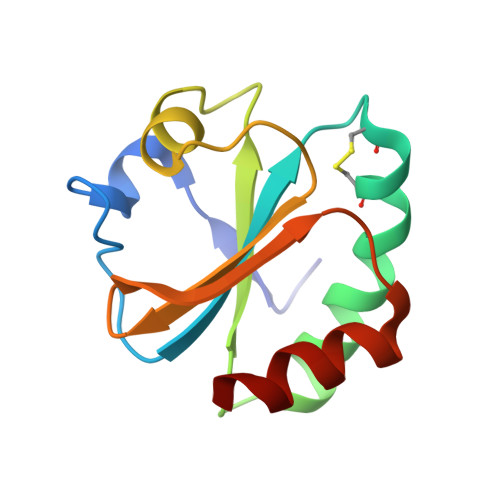Design of Disulfide-linked Thioredoxin Dimers and Multimers Through Analysis of Crystal Contacts
Das, M., Kobayashi, M., Yamada, Y., Sreeramulu, S., Ramakrishnan, C., Wakatsuki, S., Kato, R., Varadarajan, R.(2007) J Mol Biol 372: 1278-1292
- PubMed: 17727880
- DOI: https://doi.org/10.1016/j.jmb.2007.07.033
- Primary Citation of Related Structures:
2EIO, 2EIQ, 2EIR - PubMed Abstract:
Disulfide bonds play an important role in protein stability and function. Here, we describe a general procedure for generating disulfide-linked dimers and multimers of proteins of known crystal structures. An algorithm was developed to predict sites in a protein compatible with intermolecular disulfide formation with neighboring molecules in the crystal lattice. A database analysis was carried out on 46 PDB coordinates to verify the general applicability of this algorithm to predict intermolecular disulfide linkages. On the basis of the predictions from this algorithm, mutants were constructed and characterized for a model protein, thioredoxin. Of the five mutants, as predicted, in solution four formed disulfide-linked dimers while one formed polymers. Thermal and chemical denaturation studies on these mutant thioredoxins showed that three of the four dimeric mutants had similar stability to wild-type thioredoxin while one had lower stability. Three of the mutant dimers crystallized readily (in four to seven days) in contrast to the wild-type protein, which is particularly difficult to crystallize and takes more than a month to form diffraction-quality crystals. In two of the three cases, the structure of the dimer was exactly as predicted by the algorithm, while in the third case the relative orientation of the monomers in the dimer was different from the predicted one. This methodology can be used to enhance protein crystallizability, modulate the oligomerization state and to produce linear chains or ordered three-dimensional protein arrays.
Organizational Affiliation:
Molecular Biophysics Unit, Indian Institute of Science, Bangalore 560 012, India.
















